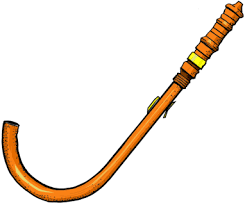Crumhorn 
The Double Reed Could Be A Device Of The Wind Family, Most Ordinarily Used Throughout The Renaissance amount. In Modern World, There Has Been A Revival Of Interest
In Early Music, And Crumhorns Square Measure Beingcompete Once More.
The Name Derives From The German Krumhorn (Or Crumhorn Or Krumporn) That Means Bent Horn. This Relates To
The english Crump That Means Curve, Living In English In 'Crumpled' And 'Crumpet' (A Arcuate Cake). The Similar Sounding French Term Double-Reed Instrument Once Used Properly Refers To A Wind Of Various Style, Althoughthe Term Double-Reed Instrument Is Commonly Utilized In Error Synonymously Thereupon Of Double Reed.
The Cromorne Could Be A Capped Reed Instrument. Its Construction Is Analogous Thereto Of The Melody Pipe Of A Wind. A Double Reed Is Mounted Within A Protracted Pipe. Processing Into The Wind cap Produces A Tone. The Pitch Of The Note May Be Varied By Gap Or Closing Finger Holes On The Length Of The Pipe. One Uncommon Feature Of The Cromorne Is Its Shape; The Top Is Bent Upwards In An Exceedingly Curve Resembling The Letter 'J'. Some individuals Suppose This Is Often So The Sound Created From The Cromorne Is Directed Toward The Player To Enhance The Intonation In Consort Enjoying.
Crumhorns Create A Robust Abuzz Sound, However Quieter Than Their Conical-Bore Relatives The Rauschpfeife And oboe. They Need A Restricted Vary, Typically A Serious Ninth. Whereas It's In Theory Potential To Urge The Reed To Overblow A Twelfth Higher Than The Basic Note, This Is Often Extraordinarily Tough As A Result Of The Reed Isn't Control Within The Mouth, And In Follow All Enjoying Is Confined To The Basic Series. Some Larger Instruments Have Their Vary Extended Down By Means That Of Further Holes And Sliders Or By Dropping The Pressure. Fashionable Instruments Have Their Vary Extended Upwards To Associate In Nursing Eleventh By 2 Keys.
Crumhorns May Be Chromatically Vie By Exploitation Cross-Fingerings, Aside From The Minor Second Higher Than the Bottom Note. Because Of The Restricted Vary, Music For Crumhorns Is Sometimes Vie By A Gaggle Of Instruments Totally Different Of Various} Sizes And Thence At Different Pitches. Such A Gaggle Is Understood As A Consort Of Crumhorns. Crumhorns Ar Inbuilt Imitation Of The Vocal Quartet With Soprano, Alto, Tenor And Bass As A
Family, As Was True Of Most Instruments Of The Renaissance. There Ar Samples Of Higher And Lower Sounding Instruments,
Of That The Good Bassis That The Solely Unremarkably Used One.
Johann Hero Schein Enclosed A Padouana À Four For Crumhorns In His Assortment Banchetto Musicale, 1617. Archangel praetorius Recommended The Utilization Of Crumhorns In A Number Of His Sacred Vocal Works As A Doable Differentto Trombones, Dulcians And Different Instruments. In Music Genre, The Cromorne Is Employed By The Dance Band Griffin. The Blibbering Humdingers Additionally used Cromorne In One In Every Of Their A Lot Of Widespread Songs, "Dobby Bang Your Head."
A Cromorne additionally Options Conspicuously In Carey Blyton's 1970 Score For The
Serial Doctor WHO And Therefore The silurians. In Ursula Dubosarsky's Novel Bruno And Therefore The Cromorne, 2 Youngsters, Bruno And Sybil, Realize them selves Learning To Play The Cromorne Nearly Unintentionally.
Crumhorn, Additionally Spelled Double-Reed
Instrument, (From English Language Crump: “Crooked”), Double-Reed instrument That Flourished Between The Fifteenth Century And Regarding 1650. It Consists Of A little Boxwood Pipe Of Cylindrical Bore, Ee Upward At The Lower Finish And Perforated With Finger Holes Like Those Of A
Recorder. Its Reed Isenveloped During A Wood Cap With A Processing Opening Within The High. The Tone Is Reedy And Nasal. Crumhorns Were Inbuilt Families, From Nice Bass To High , Every Instrument Having A Compass Of A Ninth. Their Manufacture Was Resumed Within The Twentieth Century.





No comments:
Post a Comment